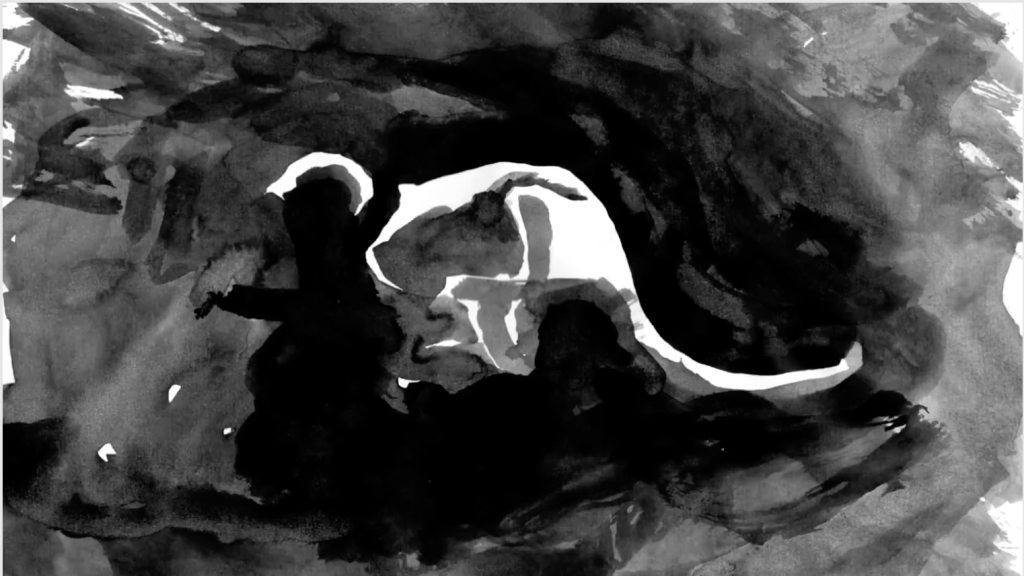ANIMATION, FILM & ANIMATION FILM
Poetics of transformation
Compared to live action, one of the specificities of animation, especially graphic animation, is its abandonment of the analogy with the real world to stage a singular world, with its rules, its codes, its laws (partly dictated by its tools)… in a particular visual proposition, imaginary, specific to the creator. It is clear that optical toys, or the Optical Theater of Emile Reynaud, precede the invention of cinema and animation does not have an imperative need for a camera: scratching on film, flip book, animated gif… We can consider, approximately, that animation is of an analytical nature, as opposed to live action, which would have a more synthetic approach of the world, even if, between the two tendencies, there is a whole range of declinations. The live action is situated in a more mimetic relationship with its subject. It reproduces movement through a sensometric process (response to the light of a sensitive surface such as a photographic plate, for example) and mechanically (scrolling images and shuttering). In animation, sets, characters and soundscapes are usually reconstituted from start to finish, down to the smallest detail. The author must define all the visual and acoustic parameters: rhythm, colors, sounds, music, forms, materials, light, which are all artistic means. These generate a series of rhetorical processes and visual figures of speech: metaphors, symbols, allegorical figures, dramatization, ornaments, oxymorons, hyperboles, substitutions, quotation effects, graphic or discursive ruptures, paradoxical spaces, rhythmic effects, irony, parody… A wide range of tropes that generate a multitude of deviations from the reality. But it is to better express the real, or to re-express it with more force and expressiveness. Concerning the metaphor, the French poet Pierre Reverdy adds: the more the relations of two brought closer realities will be distant and right, the more the image will be strong, the more it will have emotional power and poetic reality. This explains why, more often than not, animation spontaneously moves away from naturalism and more readily depicts fantastical, dreamlike or burlesque worlds. Animation becomes a formidable matrix of unusual and lyrical images, with renewed visual discoveries. Animation traditionally resorts to the process of transformation. The transformation is at work in the new forms of literary poetry in the 20th century: Dadaism, surrealism, futurism, poetic realism or Oulipo (there is also an Ouanipo, a potential animation lab). In the same way that the artistic avant-gardes also proceed of the metamorphosis and the alteration of the perception: cubism, lettrism, surrealism, futurism, optical art, Pop art, new realism… But the animation is not only the surface of the transformation of the space and the figures (as in a cubist or expressionist painting), it is of temporal nature. It operates, in a playful way, of multiple effects on the movement which slows down, freezes, accelerates, becomes jerky or goes backwards.

Between the transformed, the initial motif, and the transformer, the final motif, a relationship is established, which is, by definition, symbolic (in the sense of a relationship by similarity or convention between two objects, concepts, images, etc.). The animator creates an association of ideas between the two terms of the transformation, revealing intentions, obsessions, or even an unconscious process in the case of an improvisation exercise, for example. One thinks spontaneously of the Eisenstein montage, which proceeded by bringing together, in cut or fade, between two scenes, except that here, the transition is graphic and organic and inscribes a form of fluidity in the objects and in the characters (and even in the settings), so that their status remains continuously uncertain, unstable, equivocal: a character changes sex, an object is multiplied, a set is reversed… The style of the animator, and his graphic choices, will generate additional connotations to these symbols newly generated by the animated transformation: the artist can go from a simplified style to a grotesque, expressive or geometric style and vice versa. It is indeed a mind in motion that unfolds before our eyes.
The term of animated film (cinéma d’animation) was proposed and used in the 1950s by André Martin who wanted to differentiate the animated short films of authors (Mclaren, Trnka…), presented at the Cannes Film Festival, from the “cartoons” produced by American studios. This led to endless debates about names and definitions. Since it shares the same distribution media, animation seems to be included in cinema, in its generic meaning, and seems to use the same codes ( mise en scène, framing, point of view, editing, narration, …), etc. It is therefore common to look at an animated film as any other film, fiction, documentary or experimental, especially since these different categories have continued to hybridize over time, blurring the boundaries between these traditional classifications. For reasons of economic viability (and for the consideration of the spectator), feature-length animation is more in line with the narrative, while short films tend to be more singular in their approach.
If animated films sometimes have their own categories in festivals or in award ceremonies (like at the Magritte, the César or the Academy Awards, for example), it is rather for strategic and economic reasons. On the other hand, if animation has its own festivals, it is obviously because it has real specificities. Animated film is cinema, of course, but cinema with great expressive and poetic possibilities, whether it is when it takes hold of reality in a very documented way, with a strong societal theme, or when it summons the most fantastic imaginations (we understand here the notion of poetry in the sense of a work on language, as much verbal as visual or plastic). And it is there that the animated film reconnects with animation, in the original and pre-cinematographic sense of the term.